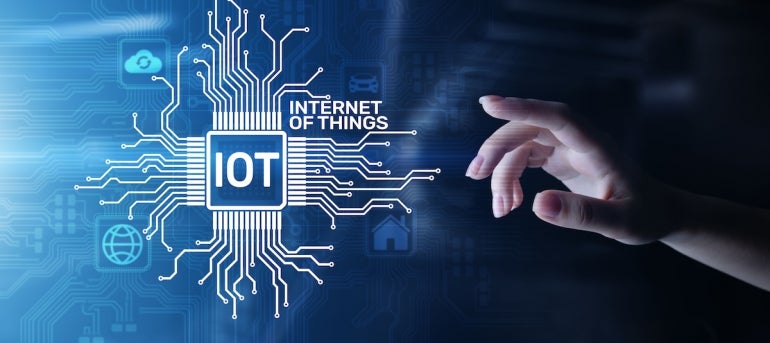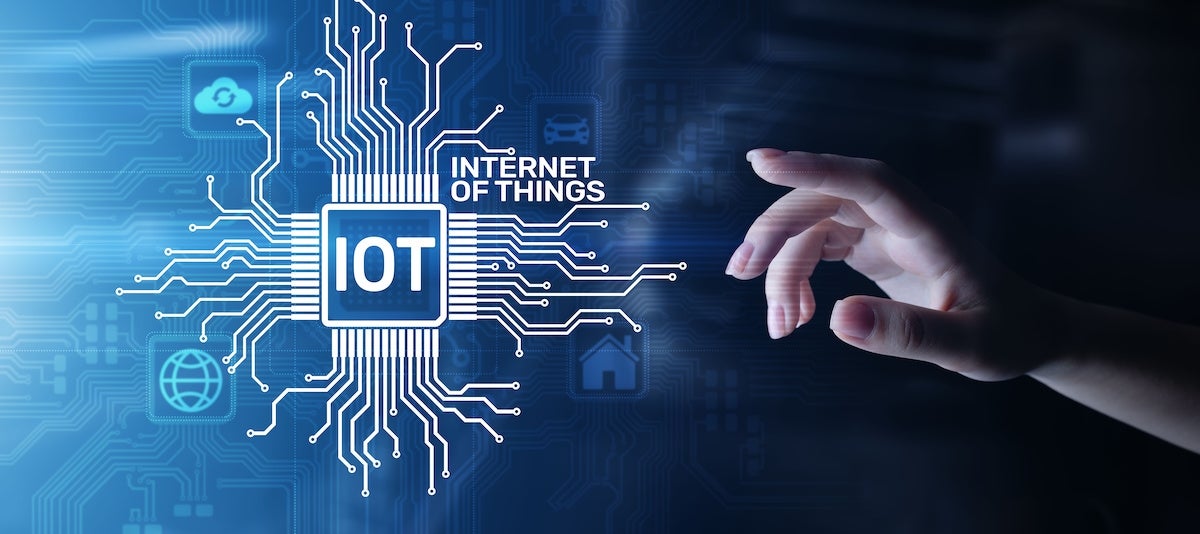
The Internet of Things, also known as IoT, refers to the billions of interconnected devices, machines and sensors that collect and exchange data via an internet connection. The resulting data is known collectively as “big data.”
Currently, IoT is taking every industry by storm. Whether it’s a sensor delivering data about the performance of a machine or a wearable used to monitor a patient’s heart rate, IoT has endless use cases. And based on recent data, IoT Analytics estimates that there will be more than 30 billion connected IoT devices by 2025.
SEE: Internet of Things policy (TechRepublic Premium)
Technology as innovative as IoT typically results in numerous questions. How does IoT work? What are its benefits? What are the potential IoT problems and solutions? This resource guide will answer all of these questions and more, so you can gain a basic understanding of IoT and its potential impact within your organization.
Jump to:
- What is the Internet of Things (IoT)?
- A brief history of IoT
- The benefits of IoT
- What are the problems with IoT?
- What are the solutions of IoT?
- Top jobs in IoT
- The future of IoT
What is the Internet of Things (IoT)?
The Internet of Things (IoT) refers to a network of devices that are connected via an internet connection. These devices are then used to gather and analyze data for a wide range of purposes in various industries.
Examples of common IoT devices include smart thermostats that learn your preferred home temperature and sensors attached to cars that alert fleet managers to upcoming maintenance needs.
There are two key categories of IoT, including the Industrial Internet of Things (IIoT) and the Consumer Internet of Things (CIoT). While one is focused on devices used for industrial purposes such as manufacturing, the other is geared toward the consumer in the form of smart devices such as wearable sensors.
How does IoT work?
The key purpose of IoT is to gather data. In most cases, devices such as sensors are connected to an IoT platform (also known as a hub or gateway). As data is gathered by the devices, it is either analyzed at the edge (known as edge computing) or sent to the cloud to be stored and analyzed at a later date.
The end user can then use the IoT platform to uncover the insights they need to make critical business decisions. Or, data insights can be sent directly to the end user in real-time.
Additional resources
- Quick glossary: Internet of Things (TechRepublic Premium)
- Quick glossary: Industrial Internet of Things (TechRepublic Premium)
- Edge computing: A cheat sheet (TechRepublic)
A brief history of IoT
In the 1980s and early 1990s, the concept of adding sensors and intelligence to commonplace items became a topic of discussion. However, the technology didn’t yet exist to make it happen, so progress was initially slow.
A breakthrough occurred in 1999 when Kevin Ashton, a British technology pioneer, coined the phrase “Internet of Things.” It was his idea to use radio frequency identification (RFID) tags to track product inventory. The idea took off and many companies began using the solution to gain visibility into their supply chains. Kevin’s IoT innovation took off.
Over the next decade, new advancements in internet connectivity and the launch of tech such as the iPhone continued to push IoT forward. Past data by Cisco found that by 2010, the number of devices connected to the internet reached 12.5 billion.
What began as a useful technology for production and manufacturing soon became critical to all industries. Now, consumers and businesses alike use smart devices and IoT daily.
The benefits of IoT
The benefits of IoT for businesses
IoT is growing fast, and businesses are relying more on IoT for operations. This is due to the many benefits offered by IoT to businesses in all industries. For example, through IoT, businesses can:
- Detect and troubleshoot issues remotely
- Monitor all business processes from one place
- Predict future maintenance needs
- Track production line efficiency
- Use data to make better business decisions
Additional resources
- How to start an IoT project at your company (TechRepublic)
- Industrial Internet of Things: Software comparison tool (TechRepublic Premium)
- Get ready for security in the age of the Extended Internet of Things, says Claroty (TechRepublic)
- How to use IoT to save money on your office bills (TechRepublic)
The benefits of IoT for personal use
IoT is also used by consumers, most commonly in the form of smart devices that simply make our lives easier. For example, consumers with smart refrigerators can check their at-home fridge stock for an ingredient from inside the grocery store. Or, they can use smart door locks to secure their homes even during travel.
However, IoT can also be used to improve our overall wellbeing. Consider, for example, wearable devices used to track a patient’s health. These devices can effectively track heart rates and other vitals, alerting emergency services or a physician in the event of a critical health event. These are just a couple of the use cases for consumers when it comes to IoT — the possibilities are endless.
Additional resources
- Self-driving trucks still need humans (TechRepublic)
- Cisco announces Wi-Fi 6E, private 5G to assist with hybrid work (TechRepublic)
- Digital twins are finally becoming a reality: Is your company ready to use them? (TechRepublic)
What are the problems with IoT?
Data privacy
A key challenge in IoT is increased data privacy risks. Devices connected to the internet are subject to risks such as undetected surveillance. These devices gather critical personal information about consumers and businesses alike. Without properly securing each device, personal information is left vulnerable.
Data security
The growth of IoT results in the expansion of a company’s attack surface. Each new device could potentially be an entry point for malware and other security risks. Unfortunately, securing this newly complex infrastructure is often difficult. In today’s business environment, not only do companies need to secure each new device they add to their network, but they must also secure the devices used by remote employees.
Data volume
As more devices connect, more data must be processed and analyzed to uncover its value. In addition, some of this data will be unstructured. The level of data analysis required to make sense of it all is challenging, especially for large enterprises. It requires a serious investment in data management and analysis tools as well as the sourcing of data talent.
Additional resources
- As IoT attacks increase 600% in one year, businesses need to up their security (TechRepublic)
- Drone defense systems: Does your company need one? (TechRepublic)
- IoT security: What you should know, what you can do (free PDF) (TechRepublic)
- Photos: The 11 least secure connected devices (TechRepublic)
What are the solutions of IoT?
IoT for manufacturing
The manufacturing industry was one of the first industries to harness the power of IoT. Manufacturing equipment can be monitored through sensors and advanced analytics. For example, tools with sensors and mobile apps can be used to help workers and technicians be more efficient and accurate, improving operational productivity and profitability. Plus, IoT combined with predictive analytics and maintenance can reduce expensive downtime in a manufacturing facility.
Additional resources
- How an Indiana IoT lab is digitally transforming manufacturing and agriculture (TechRepublic)
- The real issue behind the data science skills gap (TechRepublic)
- Bahrain selects Nokia technology for digital transformation of water infrastructure (TechRepublic)
- How IoT and big data improved Toyota’s manufacturing process (TechRepublic)
IoT for smart cities
Smart cities use sensors and other connected devices to collect data and improve operations. As a result, smart cities are often safer with better traffic regulation and efficient emergency services.
Smart cities use a variety of IoT devices, from parking sensors that alert drivers to open parking spots to video cameras in smart streetlights and gunshot detection devices. Buildings inside smart cities also use IoT solutions to improve energy efficiency.
Additional resources
- The world’s smartest cities: What IoT and smart governments will mean for you (TechRepublic)
- BYOD: Managing and securing your mobile workforce (TechRepublic)
- Raspberry Pi-powered Boom IoT sensor detects nuclear explosions, tornadoes, rockets (TechRepublic)
IoT for utilities
IoT is essential for utilities as companies scramble to keep up with consumer demand for resources. Energy and water use can be more efficient with IoT solutions. For example, smart meters can connect to a smart energy grid to more effectively manage energy flow into buildings.
Another example is smart water sensors. These sensors track water quality, temperature, pressure and usage. The resulting data is used by the water company to analyze how customers are using water and to improve efficiency. In addition, water leak detectors are used to find tiny leaks that can lead to huge water waste.
Additional resources
- Critical infrastructure IIoT/OT security projects suffer high rates of failure (TechRepublic)
- Securing the transformation journey to the edge (TechRepublic)
- Edge and field IoT storage strategies (TechRepublic)
IoT for transportation
The transportation industry is one of the fastest adopters of IoT. According to recent data, the market is expected to grow by 19.9% from 2021 to 2030. This growth is for good reason — endless opportunities exist to improve transportation through IoT.
For example, IoT sensors can help improve transportation and logistics through remote monitoring. Plus, using sensors and predictive analytics, companies can perform critical maintenance on vehicles to prevent costly downtime and safety risks.
Additional resources
- Keeping transportation safe in tomorrow’s smart city means taking wireless security seriously (TechRepublic)
- NYC, Wuhan and Albuquerque win smart city awards (TechRepublic)
- High-ROI IoT and edge solutions for environmental sustainability (TechRepublic)
IoT for retail
Within retail, IoT is helping businesses optimize their stores and providing consumers with personalized shopping experiences. For example, data from beacons, video cameras and smart shelves give retailers information on how customers shop in their stores. Plus, consumers can be helped through digital kiosks and mobile apps to give them a more personalized experience.
Retailers who use IoT make merchandising decisions based on data collected from the sensors that show how customer traffic flows through the store. Operational efficiency can be improved by better allocating staff to areas with high traffic.
Additional resources
- How to choose IIoT software: Must-have features for any business (TechRepublic Premium)
- Wi-Fi HaLow could be the next IoT enabler (TechRepublic)
- 4 ways IoT can improve the customer experience (TechRepublic)
IoT for healthcare
In healthcare, IoT is used for the care and treatment of patients, equipment maintenance and hospital operations.
For example, medical assets such as supplies and medicine can be tracked by an IoT cloud platform, vital medical equipment can be kept in top condition with predictive maintenance and sensors can be used to monitor how often a patient moves in bed.
Some patients receive care outside of a hospital setting through wearable sensors that track heart rate, blood pressure and more. When there’s a concern, their doctor is alerted and treatment can be scheduled.
Additional resources
- AT&T’s IoT connectivity helping divers in shark-infested waters (TechRepublic)
- A smart toilet may be the future of IoT healthcare (TechRepublic)
- Detected documentary: Discover how an IoT bra can detect early signs of breast cancer (TechRepublic)
IoT for smart homes
Smart light bulbs, refrigerators, thermostats and voice assistants are now commonplace within homes across the globe. Other tools such as smart home security systems enable users to monitor their homes and perform tasks such as unlocking doors remotely. All of these tools require IoT connectivity to function.
Additional resources
- How IoT is empowering the elderly to become healthier and more productive (TechRepublic)
- Top 5 smart home devices you need to know about (TechRepublic)
- IoT device managers are sticking with 4G with only 9% planning a move to 5G (TechRepublic)
Top jobs in IoT
IoT is booming, with billions of connected devices already in play and billions more predicted to be added in coming years. However, there’s a shortage of professionals with the experience necessary to implement and utilize the Internet of Things. As a result, these professionals are in high demand. Those looking for a new career in tech should consider positions within IoT.
There are three general types of IoT jobs:
Jobs that focus on the technology behind IoT projects
This includes the software, hardware and network side of things. Examples of positions include IoT solution architects, IoT software engineers, IoT analysts, cloud engineers, IoT app developers, machine learning designers/developers/engineers or IoT software developers.
Jobs that focus on big data and how to analyze it for insights
This career path includes positions such as data scientists, database architects, business intelligence (BI) analysts, data engineers and data analysts.
Jobs that focus on IoT security to keep networks and devices secure
This path includes security engineers, security analysts, security specialists, security architects, security management specialists and infrastructure engineers.
Additional resources
- 3 ways general IT pros can become IoT experts before the jobs boom (TechRepublic)
- How to become an IoT developer: 6 tips (TechRepublic)
- Why your IoT devices may be vulnerable to malware (TechRepublic)
- Cheat sheet: How to become a cybersecurity pro (TechRepublic)
The future of IoT
The number of IoT connections surpassed the number of non-IoT devices back in 2020. And IoT shows no signs of slowing down any time soon. The global consumer IoT market is expected to exceed $142 billion by 2026. Advancements such as the adoption of 5G will continue to inspire businesses and consumers alike to utilize IoT.
For businesses, the future of IoT looks like increased efficiency, an improved security posture and the ability to deliver the experiences consumers demand. For consumers, the future of IoT looks like personalized and immersive experiences, convenience through automation and a simpler way of connecting with the people and things they love.
Additional resources
- IoT could drive adoption of near-premises computing (TechRepublic)
- 17 ways the Internet of Things is changing the world (TechRepublic)
- Hiring kit: IoT developer (TechRepublic Premium)
- Blockchain will be critical for connecting IoT devices says Samsung (TechRepublic)

